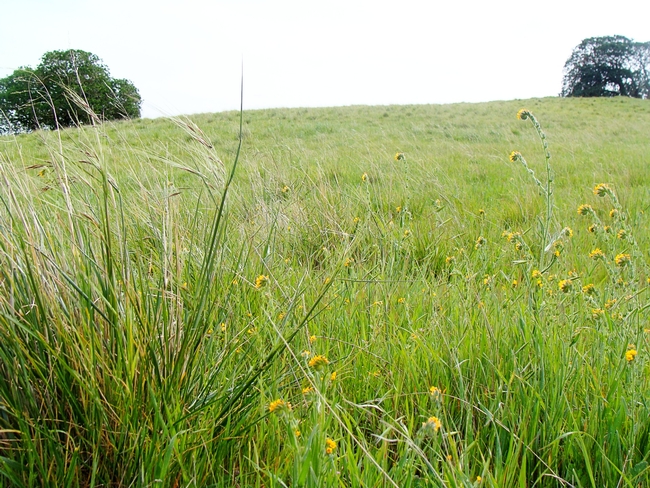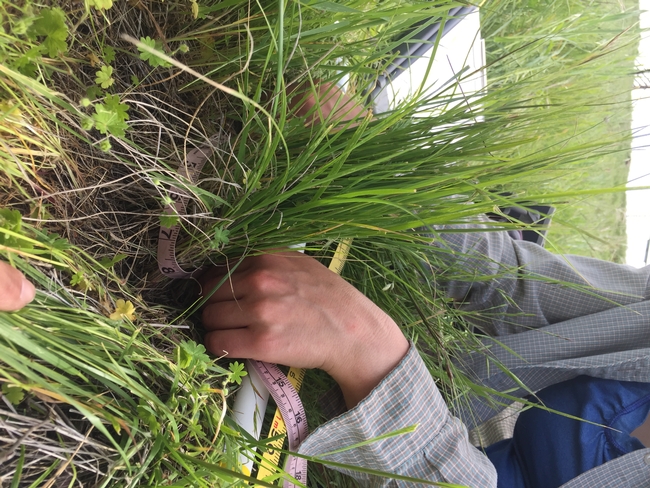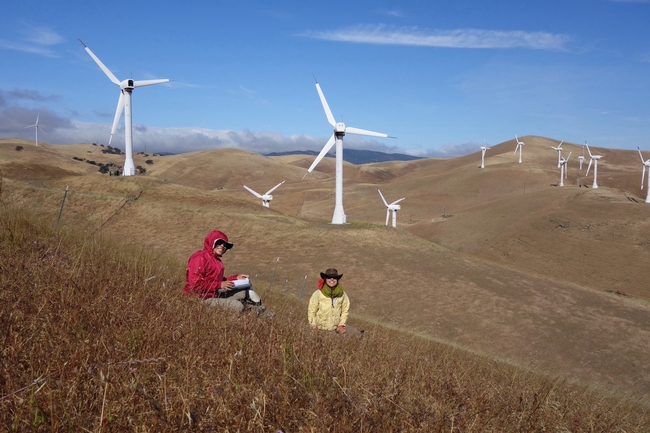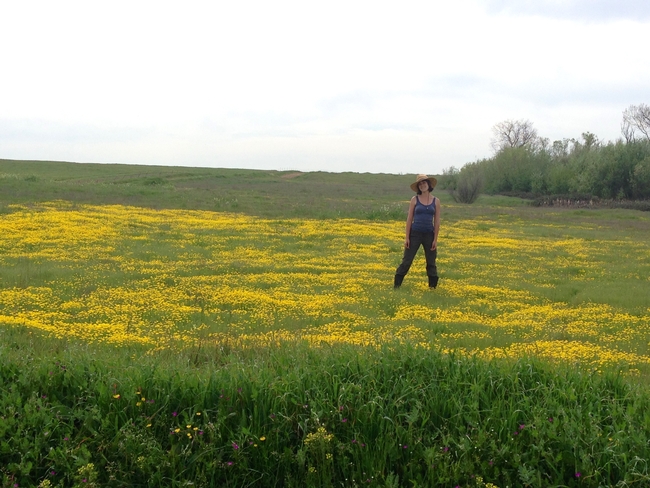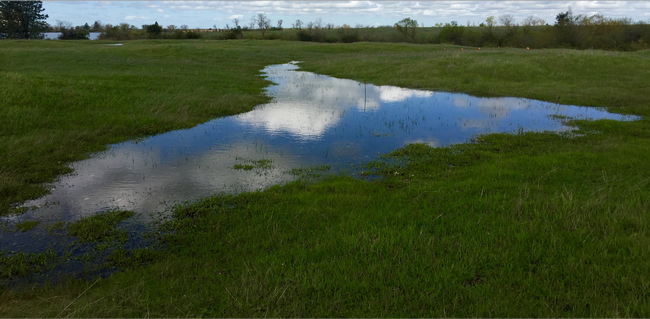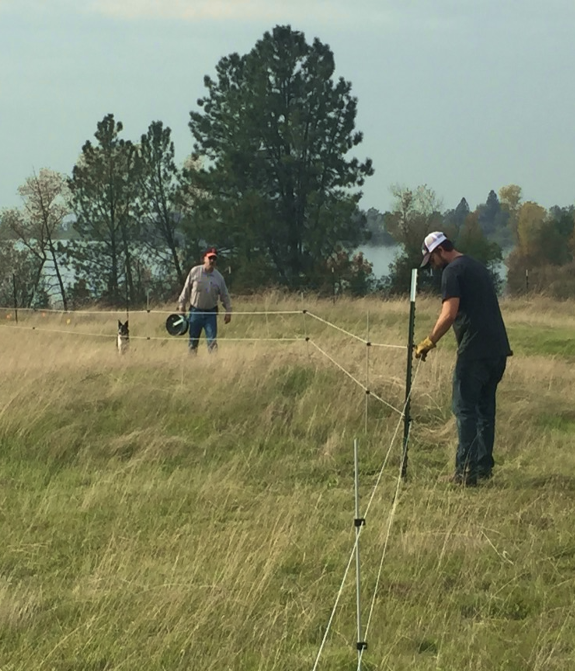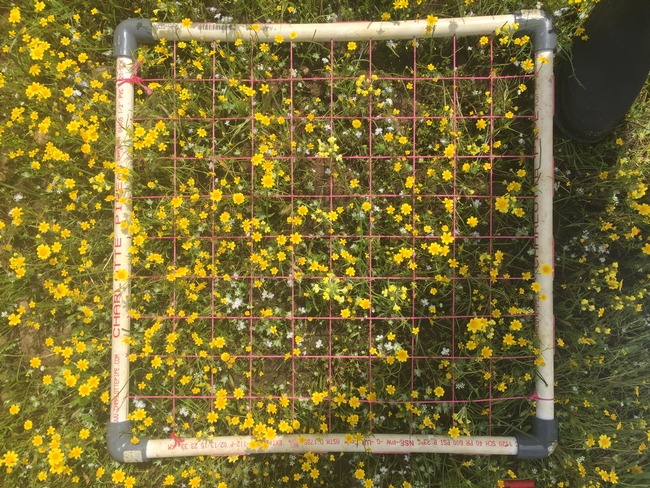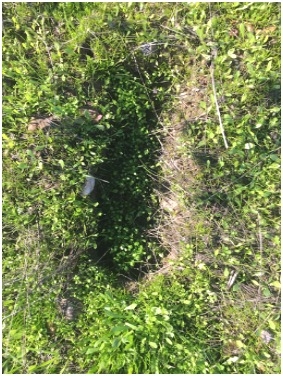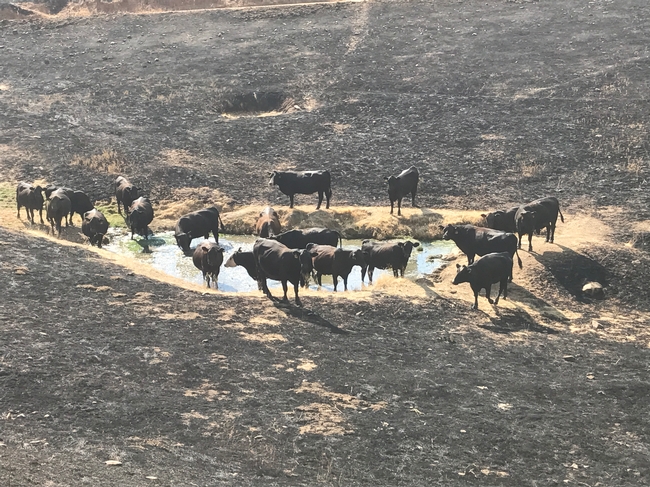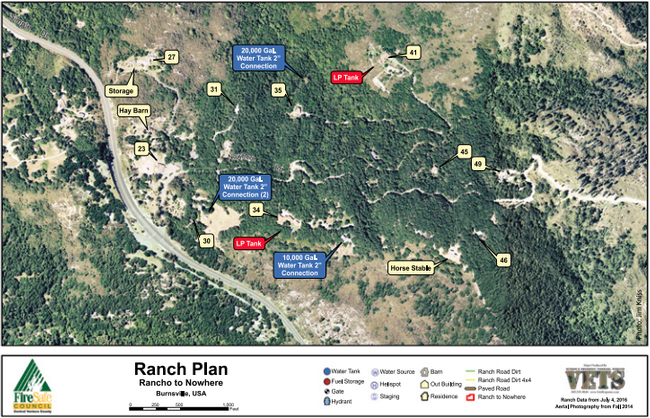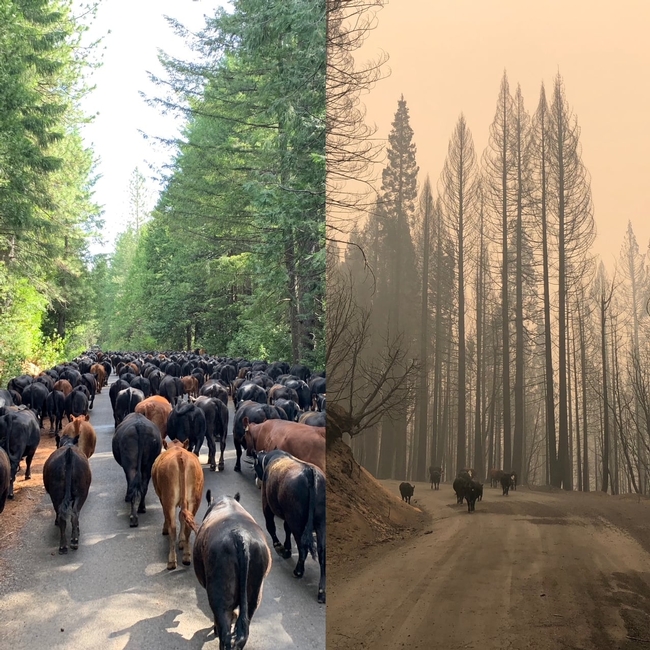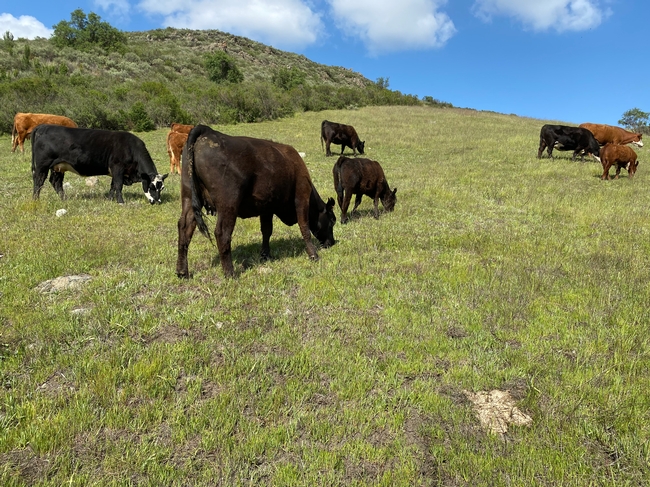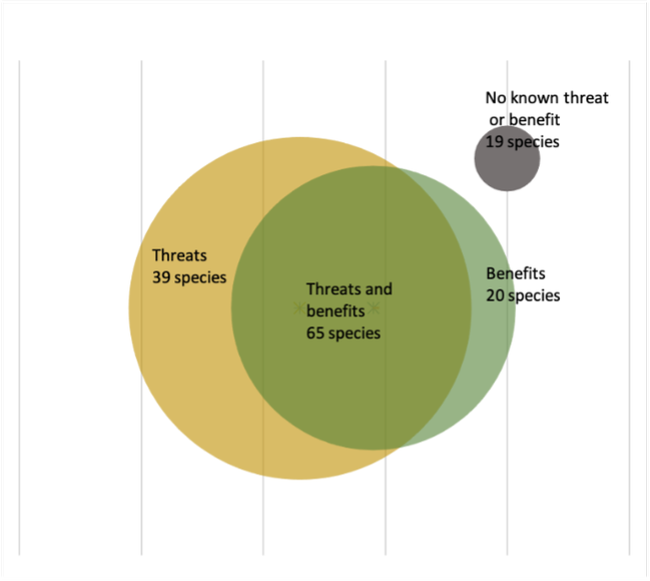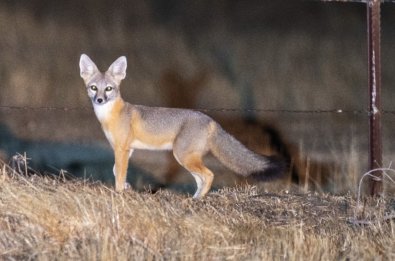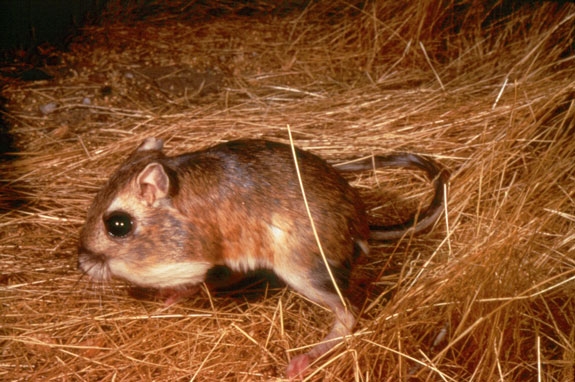Posts Tagged: cattle
Buying Livestock Drugs in California
A livestock producer recently contacted UCCE regarding a problem he was having getting livestock dewormers shipped to a California address from...
The no-tech way to preserve California’s state grass
Disappearing native is like an environmental Swiss Army knife
Though it is disappearing, California's official state grass has the ability to live for 100 years or more. New research demonstrates that sheep and cattle can help it achieve that longevity.
Purple needlegrass once dominated the state's grasslands, serving as food for Native Americans and for more than 330 terrestrial creatures. Today, California has lost most of its grasslands, and the needlegrass occupies only one tenth of what remains.
It is drought resistant, promotes the health of native wildflowers by attracting beneficial root fungi, burns more slowly than non-native grasses and speeds the postfire recovery of burned lands. For these and other reasons, many who work toward habitat restoration hope to preserve the needlegrass.
“Where it grows, these tall, slender bunches become focal points, beautiful as well as environmentally beneficial,” said Loralee Larios, a UC Riverside plant ecologist affiliated with UC Agriculture and Natural Resources. “However, identifying successful management strategies for a species that can live for a couple hundred years is challenging.”
To meet that challenge, Larios teamed up with University of Oregon plant ecologist Lauren Hallett and Northern California's East Bay Regional Park District. They tracked the health of nearly 5,000 individual needlegrass clumps over six years, including an El Niño rain year as well as historic drought.
The researchers took measurements of plant health including growth and seed production. They placed small bags over many of the grass clumps to capture the seeds and quantify the number of seeds they produced.
Their findings, now published in the Journal of Applied Ecology, were that purple needlegrass did better in places where sheep were allowed to graze. The positive effects of the grazing were amplified in times of wetter weather.
Previously, the park district spent a decade trying to assess the success of its grassland maintenance techniques. However, the district's method of applying a strategy like grazing, and then measuring the percentage of needlegrass clumps in a given area resulted in data that didn't follow a discernable pattern from year to year.
“By tracking each plant over time, rather than scanning broadly across an area, we gained much more clarity about how the grass responds to the grazing,” Larios explained. “Perhaps counterintuitively, we saw that the needlegrass generally died back when sheep weren't allowed to graze on it.”
When sheep were removed from the study sites, the needlegrass in all but two of the sites became less healthy. The researchers would like to learn whether the two sites that remained healthy have needlegrasses that are genetically distinct.
Grazing is a controversial strategy for grassland restoration. Some conservationists believe sheep eating the target grass, particularly during already stressful drought years, does not enhance their survival. As far back as the 1800s, some researchers hypothesized that the combination of grazing and drought resulted in the loss of perennial grasses.
Though drought was not beneficial for any of the plants in this study, the researchers believe grazing helped needlegrass survive in at least two ways. One, by trampling on leaf litter and other organic debris, sheep created space for new needlegrass to grow.
“Sometimes you get litter that's as deep as a pencil — so much dead, non-native grass piles up. It's hard for a little seed to get enough light through all of that,” Larios said.
Secondly, sheep eat non-native grasses that generate growth-suppressing debris and compete with purple needlegrass for resources.
When the Spanish colonized California, they brought forage grasses like wild oats that they thought would benefit cattle. Those introduced grasses spread, and now dominate the state's grasslands.
“Our grasslands are known as one of the world's biggest biological invasions,” Larios said.
California has as many as 25 million acres of grasslands, equivalent to the combined areas of Massachusetts, Connecticut, and Rhode Island. Though Larios does not believe it is possible to rid the state of all non-native grasses, she said it is possible to maintain or even increase the amount of purple needlegrass.
“It's great for carbon storage, which mitigates climate change, it doesn't serve as wildfire fuel, and cultivates a space for wildflowers that pollinators are then able to use,” Larios said. “We want to keep all those benefits.”
Once perceived as a problem, conservation grazing by cattle a boon to vernal pools
Giving 1,200-pound cows access to one of California's most fragile and biologically rich ecosystems seems a strange way to protect its threatened and endangered species.
But a recently published study suggests that reintroducing low to moderate levels of cattle grazing around vernal pools – under certain conditions – leads to a greater number and greater variety of native plants.
Ecologists consider vernal pools – ephemeral ponds that form seasonally – “islands of native habitat” amid California's grasslands that are dominated by exotic grasses. These biodiversity hotspots harbor about 200 native species of animals and plants, such as the coyote thistle, which germinates under water and forms a snorkel-like straw to deliver oxygen to its roots – and then “fills in” its stem as the pool dries.
Specially adapted to survive in those stages of wet and dry, many of these species are found only in vernal pools scattered across California – making those pools an urgent priority for conservationists.
During the 1970s and 1980s, vernal pools were fenced off in parts of the state, in the hopes of protecting the flora and fauna from grazing cattle. In the early 2000s, however, UC Davis researcher Jaymee Marty found that grazing was actually crucial to vernal pool biodiversity: once livestock were removed from areas that had been grazed historically, the diversity of plants plummeted.
“Her research was critical to rethinking the best ways to protect the diversity in California's vernal pool ecosystems,” Eviner said.
The Michaels-led study, published in the Journal of Applied Biology, builds on Marty's work, by looking at scenarios where cattle had been blocked from vernal pools for decades, and then observes the rate at which biodiversity returns after reintroduction of the animals. Michaels said she wanted to provide some initial answers to the practical questions that ranchers and land managers have in potentially reintroducing cattle.
“A lot of them had these areas that had been fenced off from grazing for the last 20–30 years, and they were very concerned about what happens if we let cattle back onto these vernal pool grasslands – are there going to be negative impacts because that land had been at rest for a few decades?” Michaels explained.
They discovered that, after reintroducing cattle to areas that had been fenced off since the 1970s, there was a greater abundance of native flora (species like the vernal pool buttercup, bractless hedge-hyssop and bristled downingia), as well as increased diversity among the plants (both in number of species and in how evenly distributed they were).
“Encouragingly, diversity is rapidly restored,” Eviner said, “providing conservationists with strong data to show that rapid action can enhance plant diversity.”
And as for potential worries about cattle making a snack of vernal pool plants, Michaels and her colleagues observed that the cattle appear to be more interested in munching on grasses.
“Anecdotally, we saw very few signs of herbivory on the vernal pool species because the timing is such that [the plants] are underwater for a good part of the late winter and early spring, and then by the time they're blooming, there's plenty of good forage around for the cattle,” Michaels said.
In fact, the cattle seem to be performing a function filled for millennia by native grazers (namely, the once-abundant tule elk), helping to knock down vernal pool species' chief competitor in those transition zones: the grasses.
Instead, microdepressions created by the cattle appeared to encourage the proliferation of native plants. Each hoofprint became a miniature basin – “a vernal pool within a vernal pool.”
“Right in those transition zones, where they could be hosting either the vernal pool species or the upland grasses, just a couple centimeters of soil topography can make a big difference,” Michaels explained. “If a cow comes and steps in that transition zone, and that lowers the soil surface so it stays inundated a little longer, you end up seeing these pockets of vernal pool species that are able to persist.”
Michaels is currently conducting a follow-up study on the hoofprints to pinpoint their role in boosting native plant abundance and biodiversity. Because the prints can last for several years, they might be able to deliver some enduring benefits – and land managers might not have to bring cattle in to graze the pools as often.
“If it's really the hoofprints making the big difference, maybe we don't need to graze every year – only during certain times of year when we know the hoofprints will form well and harden, and then we're good for a few years,” Michaels said.
Ag Pass program aims to improve wildfire preparedness on rangeland
When the Detwiler Fire broke out near his family's ranch in 2017, Tony Toso was home to take defensive action to protect his family and animals. The Mariposa County rancher feels fortunate that he was on site.
“We were on the front end of the fire damage and it started on a Sunday,” recalled Toso. “Had I not been home that day, it would have been very difficult for me to access my property and help keep our livestock safe. Within a matter of hours of the fire starting, the CHP had our county road closed and would not let anyone in.”
Emergency personnel close roads around wildfires for the safety of people and to prevent them from impeding fire suppression efforts. When fire threatens large ranching operations, ranchers need to move their livestock out of harm's way and make sure they have feed and water. While volunteer groups can assist in rescuing dogs, cats, and a few sheep or horses, they don't have a rancher's knowledge, expertise and experience that are essential for managing hundreds of cattle at large-scale ranching operations.
To help rural communities prepare for wildfire, it would be helpful for farmers and ranchers to have a plan in place to coordinate with first responders, according to Max Moritz, UC Cooperative Extension wildfire specialist. Ag Pass is a program developed in Ventura County to identify farmers and ranchers to firefighters, law enforcement and other emergency personnel so they can allow them onto their property to rescue animals and identify access roads and water sources.
“Because fires are increasingly impacting people and are not going away anytime soon, we need to figure out approaches to sustainably live on fire-prone landscapes. In a broader sense, the Ag Pass is another way that we can adapt to, and coexist with, wildfire,” Moritz said.
Matthew Shapero, UC Cooperative Extension livestock and range advisor, and Moritz have written a publication to guide people who would like to create an Ag Pass Program for wildfire preparedness in their own locale.
“Our neighbors had cattle just north of us and they tried to get in and could not,” said Toso. “An Ag Pass in that situation, would have been a huge benefit had I not been at home and then wanted to access my property.”
In Ventura County, agricultural workers can apply for identification cards from the Central Ventura County Fire Safe Council, which verifies farm information through the county's pesticide applicator permit database. Ag Pass members provide detailed maps of their farms that show access roads – including many that don't show up on other maps.
Shapero, who works in Ventura and Santa Barbara counties, has been working with ranchers and county agencies to create an Ag Pass program in Santa Barbara County.
“The last few fire seasons have made a program like the Ag Pass more urgent than ever, especially as awareness of wildfire's impacts to agriculture has grown,” Shapero said. “We hope that this publication provides localities with a workable blueprint that will expedite the adoption of this or similar programs.”
Shapero has been working with Anthony Stornetta of Santa Barbara County Fire and representatives of other agencies to develop a training for Ag Pass participants in Santa Barbara County.
“After being at the Carr, Sonoma, Creek and Camp fires for months at a time, I started developing the program from the fire side and presented it to California Cattlemen's Association a couple years ago,” Stornetta. “This was a great collaborative effort. After meeting with our fire safe council, we are looking at the program being fully adopted very soon.”
In September, the Bear Fire raged through the Plumas National Forest where 400 of Dave Daley's cattle roamed to graze. The fifth-generation rancher wrote in moving detail of his grueling search for surviving cows in the rugged terrain during the wildfire and posted it to the California Cattlemen's Association website.
“I was unable to get access initially,” Daley said. “After working with our sheriff, I was able to get access through his office. But it required a deputy to take his time every day for 10 days to meet me at the roadblocks and escort me for several miles into our cattle range. I am very thankful for their willingness to do so. However, it was probably not the best use of their time when they were dealing with so many crises simultaneously and the fire was still raging. If there had been an Ag Pass system, that would have simplified the process, freed up law enforcement and given me a chance to save more cattle.”
Toso, the Mariposa County rancher and president of the California Cattlemen's Association, thinks a program as described in the UC Cooperative Extension publication benefits both ranchers and first responders.
“We can not only help protect ranching families, but we can use the opportunity to build working relationships and create trust between landowners and emergency personnel, as well as provide valuable information to those first responders from knowing the lay of the land,” he said. “Helping other counties and our member ranchers get a program on the books with their respective counties will be a priority for our organization.”
“Given each community's unique agency and personnel structure, it is our belief that the Ag Pass is best administered at the local or county level, however we are working with the state to see if policy measures can be developed that would simplify and support the Ag Pass concept,” Shapero said.
The training developed for Santa Barbara County includes an overview of hazards and safety issues, entrapment avoidance, incident organization, fire behavior, working with law and fire liaisons, access to incident, carding and certification. Stornetta anticipates the Santa Barbara County training will be held in spring 2021 and hopes it can be used in other counties as well. Ranchers who are interested in the Ag Pass training should contact Stornetta or Shapero.
“Preparing for Disaster: Establishing an Ag Pass Program in Your Community,” can be downloaded for free at https://anrcatalog.ucanr.edu/pdf/8685.pdf.
(First published Dec. 21, 2020)
Beef cattle grazing more help than harm for endangered plants and animals
Well-managed grazing can control non-native plants and maintain habitat and ecosystems to support a variety of species
Research recently published in the journal Sustainability documents a role for livestock grazing to support the conservation of imperiled plant and animal species in California.
Livestock grazing occurs in every county except San Francisco and is the single greatest land use in California. Grazing livestock, primarily beef cattle, often share lands with threatened and endangered species. California has more federally listed threatened and endangered species (287 plants and animals) than any other state in the continental US. While this is a result of our state's varied climate, soils and topography, the threat to diversity is predominantly from habitat loss due to land use change. Housing and urban development, solar and wind farms, cultivated agriculture, and public works projects such as reservoirs, roads and high-speed rail all result in habitat loss for some native species, many of which are threatened or endangered. Alternatively, maintaining ranching, or managed grazing for beef cattle production, can support the conservation of many threatened and endangered species in California.
A review of United States Fish and Wildlife Service (USFWS) listing documents for threatened and endangered species in California provided an opportunity to understand the relationship between livestock grazing and species conservation. Based on USFWS documents, 51%, or 143, of the federally listed animal and plant species are found in habitats with grazing. Livestock grazing is a stated threat to 73% (104) of the species sharing habitat with livestock, but 59% (85) of the species are said to be positively influenced, with considerable overlap between species both threatened and benefitting from grazing. The fact that USFWS identifies grazing as both a threat and a benefit to many species indicates that how grazing is done matters.
While species may be negatively impacted by grazing that is excessive or unmanaged, managed grazing can control vegetation and maintain habitat structure and ecosystem function to support a variety of species. Controlling non-native species, mostly non-native annual plants, is the most frequent reason that grazing benefits both federally listed flowering plant and animal species in California. In fact, 89% of species positively impacted by livestock grazing benefit from control of non-native species. For example, controlling non-native annual grasses favors native forb or broad-leaf plant populations that support the conservation of 10 different butterfly species and one moth species which rely on forbs for nectar and larvae food.
In addition to controlling non-native plants, grazing benefits some listed species by controlling vegetation, including thatch or dead plants that alter habitat. In the grasslands and shrublands of the San Joaquin Valley, maintaining habitat with sparse vegetation supports a variety of listed species, including the Kern mallow plant (Eremalche parryi ssp. Kernesis), the blunt-nosed leopard lizard (Gambelia silus), the giant kangaroo rat (Diposdomys ingens), and the San Joaquin kit fox (Vulpes macrotis). For the small ground-dwelling animals, annual grass and thatch can create an impenetrable thicket. For the larger native animals like the San Joaquin kit fox, taller, dense vegetation can obscure the visibility of predators. Habitat with sparse vegetation is also necessary for listed plant and animal species in coastal grasslands, including the Santa Cruz tarplant (Holocarpha macradenia) and Ohlone tiger beetle (Cicindela ohlone).
Some species (plants, insects and a reptile) benefit from grazing that controls vegetation associated with air pollution. The USFWS cites research that shows air pollution, specifically dry atmospheric nitrogen deposition, creates a fertilizer load that alters plant communities and habitat, and livestock grazing can restore or maintain habitat by removing excess vegetation and nitrogen. The control of vegetation through grazing is also associated with maintaining grasslands by preventing succession or invasion by brush to benefit some animal and plant species. For listed plants like the Western Lily (Lilium occidentale) that are threatened by loss of grassland, the USFWS has stated that the benefits of grazing seem to outweigh the potential threat to these plants being grazed or trampled.
Within aquatic habitats, species benefitting from grazing, which includes flowering plants, amphibians and invertebrates, are primarily found in temporary or vernal pools, where livestock help maintain an adequate inundation period. Listing documents for species in temporary pools cite research that describes increased grass cover in and around ungrazed vernal pools leading to increased evapotranspiration and decreased pond duration. Other benefits stated for listed species in aquatic habitats include two animal species that benefit from the presence and maintenance of stock ponds associated with livestock grazing.
This review of the USFWS listings documents concludes that many federally listed species in California are conservation reliant, requiring continued interventions to support their lifecycle or maintenance of habitat, and that sharing land with livestock grazing is an important conservation strategy. Species benefiting from grazing are often threatened by the loss or cessation for grazing. Most, if not all, ecosystems on the planet have been altered by land use and other anthropogenic effects. Threats to biodiversity stemming from pervasive non-native species, climate change, and the disruption of essential ecosystem processes and disturbance regimes are not typically overcome simply by preserving land, improving regulatory protections, and removing threats. Livestock grazing is perhaps the only ongoing land use that can be feasibly manipulated to manage vegetation and habitats at the landscape scale.
To read the journal article “Rangeland Land-Sharing, Livestock Grazing's Role in the Conservation of Imperiled Species,” visit https://www.mdpi.com/2071-1050/13/8/4466.
To learn more about livestock grazing and beef cattle production in California, see the "Understanding Working Rangelands" fact sheet series:
- Bay Area Ranching Heritage: A Continuing Legacy
https://anrcatalog.ucanr.edu/pdf/8528.pdf
- Cattle, Sheep, Goats, and Horses: What's the Difference for Working Rangelands
https://anrcatalog.ucanr.edu/pdf/8524.pdf
- Ranching Infrastructure: Tools for Healthy Grasslands, Livestock, and Ranchers
https://anrcatalog.ucanr.edu/pdf/8561.pdf
- Sharing Open Space: What to Expect for Grazing Livestock
https://anrcatalog.ucanr.edu/pdf/8516.pdf
- Caring for Cattle to Provide Safe and Wholesome Meat
https://anrcatalog.ucanr.edu/pdf/8530.pdf
- Cows Need Water, Too: Water Sources, Wetlands, and Riparian Areas
https://anrcatalog.ucanr.edu/pdf/8525.pdf
- Grazing Systems Management
https://anrcatalog.ucanr.edu/pdf/8529.pdf


